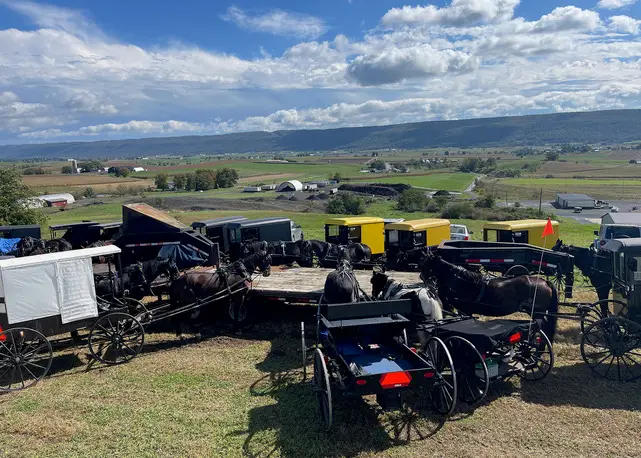Although many would view this lifestyle as very difficult, the Amish consider it a precious privilege to raise their children in a home and community setting that is more shielded from the technology, images, and interruptions that are a constant part of life among the non-Amish.
What Are the Basic Beliefs of the Amish?
The Amish believe that:
- The Bible is the inspired word of God.
- There is one God eternally existing as Father, Son, and Holy Spirit (Romans 8:1-17).
- God loved the world so much that He gave His only Son, Jesus, to die on the cross for the sins of the world.
- Through faith in the shed blood of Jesus, we are reconciled to God.
- Salvation is by grace through faith in Christ, a free gift bestowed by God on those who repent and believe.
- As Christians, we should live as brothers.
- The Holy Spirit convicts of sin and empowers believers for service and holy living. The church is separate from the state.
- We are committed to peace.
- Faith calls for a lifestyle of discipleship and good works.
Why Don’t the Amish Use Modern Technology?
The Amish and Mennonites believe that God has called His followers to separate themselves from the world. They interpret this to mean that the materialistic desires of the rest of the world should not be a part of their culture. An important aspect of Amish culture is a simpler lifestyle, such as using horses and buggies for transportation, which helps maintain a close-knit community.
Why Don’t the Amish Use Electricity?
Amish people interpret connecting to electrical wires as a connection to the world, and the Bible tells them not to be conformed to the world (Romans 12:2). In 1919, Amish leaders agreed that connecting to power lines would not be in the best interest of the Amish community. They did not make this decision because they thought electricity was evil in itself, but because easy access could lead to many temptations and the deterioration of church and family life. The Amish value simplicity and self-denial over comfort, convenience, and leisure. As a result, there is a bonding that unites the Amish community and protects it from outside influences such as television, radios, and other distractions.
Why Will the Amish Ride in Automobiles If They Will Not Own Them?
By rejecting certain types of modernity and accepting others, some Amish may appear to the outside world to be contradicting themselves. However, from the viewpoint of Amish culture, there is no contradiction. Although the Amish may not own a car, a member may accept rides and hire an automobile with a driver for transportation. There was little hesitation when the Amish decided against car ownership, as it would separate the community in various ways. If only wealthy members could afford a car, it would bring inequality. Proud individuals might use it to show off their status, power, and wealth. Cars would also speed things up dramatically, disrupting the slow pace of Amish living. So, they will use them but not own them, as ownership could lead to chaos.
Do the Amish Use Modern Medicine and Doctors?
Most Amish and Mennonite groups do not oppose modern medicine. Their readiness to seek health services varies from family to family. Nothing in the Amish understanding of the Bible forbids them from using modern medical services, including surgery, hospitalization, dental work, anesthesia, and blood transfusions. However, they believe that good health, both physical and mental, is a gift from God and requires careful stewardship on the part of the individual. They do not have hospitalization insurance, but they band together to help pay medical expenses for anyone in their group who needs financial assistance.
Do the Amish Pay Taxes?
Self-employed Amish do not pay Social Security tax. Those employed by non-Amish employers do pay Social Security tax. The Amish pay real estate, state and federal income taxes, county taxes, sales tax, etc. The Amish do not collect Social Security benefits, nor do they collect unemployment or welfare funds. Self-sufficiency is the Amish community’s answer to government aid programs. Section 310 of the Medicare section of the Social Security Act has a subsection that permits individuals to apply for exemption from the self-employment tax if they are members of a religious body that is conscientiously opposed to Social Security benefits but makes reasonable provisions for taking care of their own elderly or dependent members. The Amish do not have retirement communities or nursing homes; in most cases, each family takes care of its own, and the Amish community provides assistance as needed.
Does Anyone Ever Join or Leave?
Anyone is welcome to join the Amish and Mennonites as long as they are willing to meet the requirements for membership. These requirements vary; they are more rigid among the Amish and conservative Mennonites and more relaxed among moderate and liberal Mennonites. It is very rare for someone to join the Amish, but it does happen occasionally. People also leave the Amish and Mennonites. Most people who leave the Amish become Mennonites.
Why Do Amish Men Have Beards but Not Mustaches?
Several scriptures mention beards in the Bible. An example is Psalm 133:1-2. An Amish man does not shave his beard after he becomes married. A long beard is the mark of an adult Amish man. Mustaches, on the other hand, have a long history of being associated with the military and are therefore forbidden among the Amish.
Why Do They Dress the Way They Do?
The plain and simple dress of the Amish is an outward expression of their inner convictions of humility and modesty. They also believe it is important to differentiate the roles between men and women, which is why Amish and many Mennonite women wear dresses. The head coverings of the women are related to a biblical reference in 1 Corinthians 11, which emphasizes the need for women to have their heads covered.
What Is Their Education System Like?
While the majority of Mennonites embrace high school and college education, the Amish and some Mennonites do not believe higher education is necessary. All Amish children attend school at least until their eighth-grade year.



